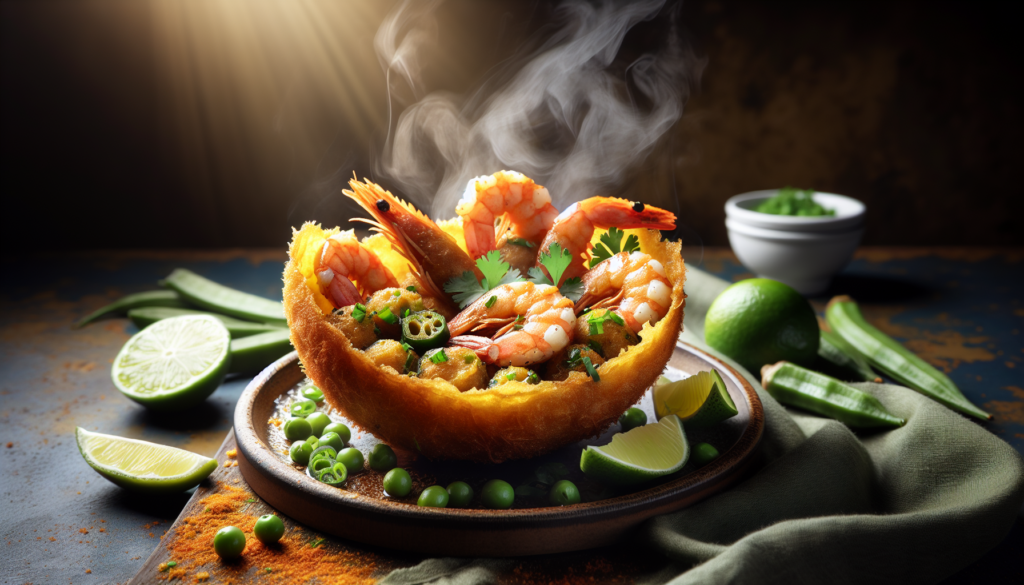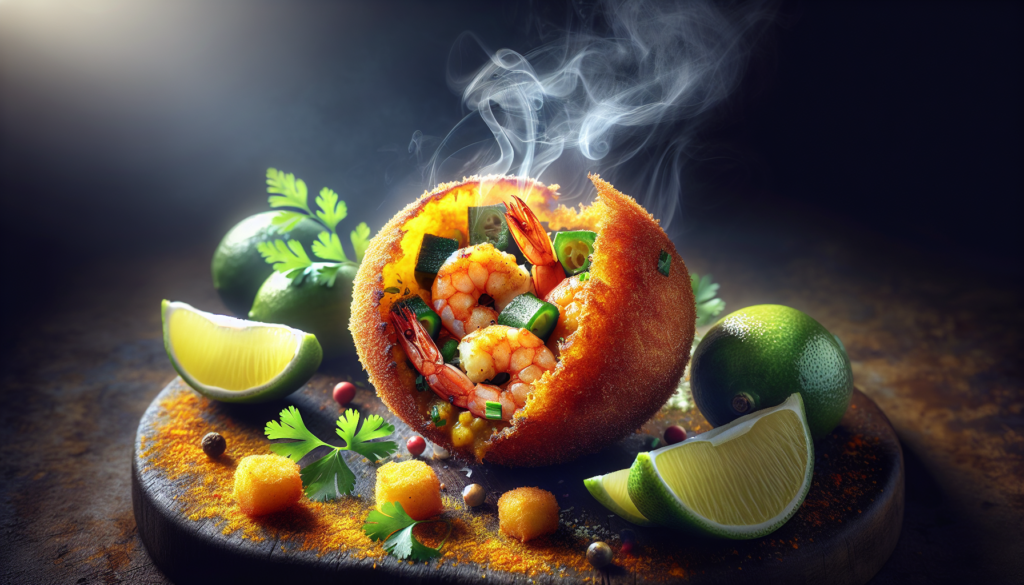Get ready to tantalize your taste buds with the delicious flavors of authentic Acarajé, a traditional Brazilian dish. This mouthwatering recipe takes you on a culinary journey to Brazil, where the rich blend of flavors and spices will transport you to the vibrant streets of Bahia. Get ready to explore the world of Brazilian cuisine as you discover the secrets behind this beloved dish. From the golden brown fritters to the flavorful shrimp filling, every bite is a delightful explosion of taste. So tie your apron and let’s embark on a flavorful adventure as we delve into the art of cooking this beloved Brazilian delicacy.

Ingredients
Main ingredients
To make authentic acarajé, you will need the following main ingredients:
-
Black-eyed peas: The base of the acarajé dough, these peas are soaked and blended to create a soft and fluffy texture.
-
Onion: Adds flavor and sweetness to the dough.
-
Garlic: Enhances the savory taste of the acarajé.
-
Salt: Balances the flavors in the dough.
-
Palm oil: Essential for frying the acarajé, palm oil also adds a distinct flavor to this dish.
Spices and seasonings
To elevate the taste of your acarajé, the following spices and seasonings are traditionally used:
-
Red chili pepper: Adds a spicy kick to the filling and sauce.
-
Dried shrimp: Provides a unique umami flavor to the acarajé.
-
Ginger: Adds warmth and depth of flavor to the dish.
-
Cilantro: Brightens up the flavors and adds freshness to the sauce.
Preparation
Soaking the black-eyed peas
Start by soaking the black-eyed peas in water for at least 6 hours or overnight. This process softens the peas, making them easier to blend later on. Rinse the soaked peas thoroughly before using.
Peeling and blending the black-eyed peas
After soaking, drain the peas and remove the skins by rubbing them gently with your hands. This step is time-consuming but crucial for achieving the smooth texture of the acarajé dough. Once peeled, blend the peas in a food processor until you have a thick and creamy batter.
Preparing the filling
Traditionally, the filling for acarajé consists of shrimp cooked with onion, garlic, ginger, and dried shrimp. Heat some palm oil in a pan, add the seasonings, and cook until fragrant. Then add the shrimp and cook until they turn pink and opaque. Set the filling aside for later.
Preparing the sauce
The sauce for acarajé is made by blending red chili pepper, garlic, dried shrimp, ginger, and cilantro together. The resulting sauce should be vibrant and spicy, with a hint of umami flavor from the dried shrimp. Adjust the spice level to your preference.
Frying the acarajé
To fry the acarajé, heat palm oil in a deep pan or skillet. Using a spoon, scoop a portion of the batter and carefully drop it into the hot oil. Fry until both sides are golden brown and crispy. Remove from the oil and drain excess oil on a paper towel.
Serving and Enjoying
Garnishing and toppings
Acarajé is traditionally served with a variety of garnishes and toppings. Common options include vatapá (a rich and creamy shrimp paste), caruru (a spicy okra stew), thinly sliced tomatoes, and lettuce. Some people also like to add hot sauce or extra cilantro for added flavor.
Serving suggestions
Enjoy your acarajé while it’s still warm and crispy. This dish is often enjoyed as a street food snack, but it can also be served as a main course. Pair it with a refreshing caipirinha cocktail or a cold coconut water for the ultimate Brazilian culinary experience.
Tips and Variations
Making vegetarian or vegan acarajé
To make a vegetarian version of acarajé, simply omit the shrimp from the filling. You can enhance the flavor by adding more spices and seasonings, such as cumin or paprika. For a vegan option, substitute the palm oil used for frying with a neutral vegetable oil.
Substituting ingredients
If black-eyed peas are not readily available, you can use pigeon peas or even chickpeas as a substitute. The texture and taste will be slightly different, but the result will still be delicious.
Adding different fillings
While shrimp is the traditional filling for acarajé, you can experiment with different options based on your preferences. Some popular alternatives include fish, ground beef, or even a combination of vegetables and cheese. Get creative and tailor the filling to your liking!

History and Cultural Significance
Origins of acarajé
Acarajé originated from the culinary traditions of the Yoruba people in West Africa. It was brought to Brazil during the transatlantic slave trade, where it evolved and became an iconic dish in Afro-Brazilian cuisine. Today, it is closely associated with the state of Bahia and its vibrant cultural heritage.
Role in Afro-Brazilian cuisine
Acarajé is not just a culinary delight but also an important symbol of Afro-Brazilian culture and religious practices. It is often sold by women known as “baianas” who dress in traditional attire and carry the acarajé on their heads. These vendors play a significant role in preserving the cultural traditions and flavors of Brazil.
Symbolism and cultural events
In the Afro-Brazilian religion of Candomblé, acarajé is considered an offering to the deities. It is commonly found in religious festivals and ceremonies, such as the famous Lavagem do Bonfim in Salvador, Bahia. This event brings together people from different backgrounds to celebrate their shared heritage and enjoy the flavors of acarajé.
Nutritional Value
Calories and macronutrients
Due to the deep frying process and the use of palm oil, acarajé is a relatively high-calorie dish. One serving of acarajé, including the filling and sauce, can contain around 400-500 calories. It is also a good source of protein and dietary fiber, thanks to the black-eyed peas and shrimp.
Health benefits
Although acarajé is a treat best enjoyed in moderation, it still offers some nutritional benefits. The black-eyed peas provide essential nutrients like folate, iron, and magnesium. Additionally, the spices used in acarajé, such as ginger and garlic, have anti-inflammatory and digestive properties.
Acarajé in Popular Culture
Acarajé in literature and arts
Acarajé has made appearances in Brazilian literature and arts, often depicted as a mouthwatering symbol of Bahian culture. Renowned Brazilian author Jorge Amado featured acarajé in his novels, highlighting its significance in both gastronomic and social contexts.
Famous acarajé vendors
In Bahia, there are legendary acarajé vendors who have become cultural icons. These baianas have perfected the art of making acarajé and have attracted visitors from all over the world with their skill and dedication. Dona Dinha, Maria do Céu, and Cira are just a few of the famous names synonymous with exceptional acarajé.
Regional Variations
Acarajé in Bahia
In its birthplace of Bahia, acarajé remains the most well-known and cherished version of this dish. It is often enjoyed with traditional accompaniments like vatapá, caruru, and additional toppings.
Acarajé outside of Bahia
While acarajé is deeply rooted in Bahian culture, its popularity has spread to other regions of Brazil. In cities like São Paulo and Rio de Janeiro, you can find acarajé stands and restaurants serving this tasty treat, allowing people from all over the country to experience its unique flavors.
Similar Dishes in Brazilian cuisine
Differences from other traditional dishes
Acarajé stands out among other traditional Brazilian dishes due to its distinct African influence. While dishes like feijoada and pão de queijo represent different aspects of Brazilian cuisine, acarajé’s connection to Afro-Brazilian culture makes it a unique and emblematic dish.
Similar street-food snacks
In addition to acarajé, Brazil boasts an array of delicious street-food snacks. Coxinha, a deep-fried chicken-filled pastry, and pastel, a savory pastry filled with various ingredients, are popular choices. While these snacks may differ in taste and preparation, they all share the common theme of being enjoyed on the go.
Conclusion
Embracing the flavors and traditions
Acarajé is more than just a delicious snack; it represents the culinary heritage and cultural diversity of Brazil. By preparing and savoring this authentic dish, you are not only indulging in a delightful gastronomic experience but also honoring the centuries-old traditions that have shaped Brazilian cuisine. So, grab your apron, gather the ingredients, and embark on a flavorful journey with acarajé!
